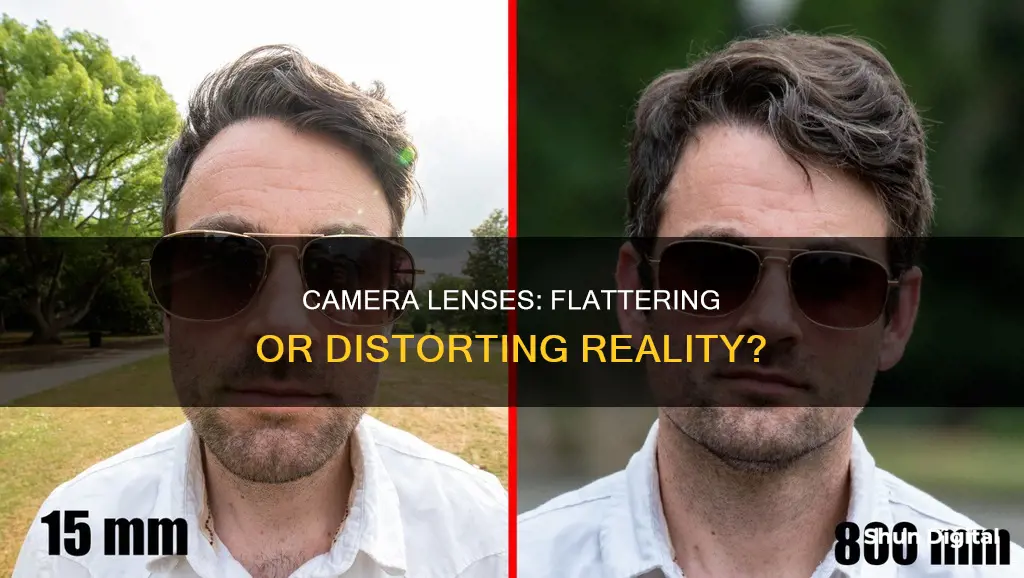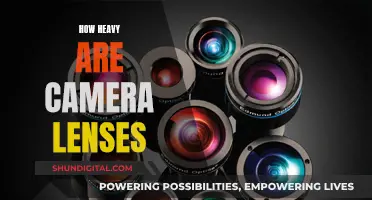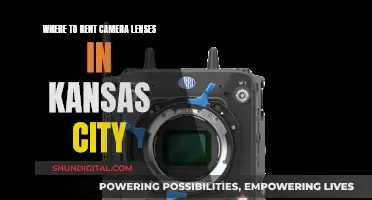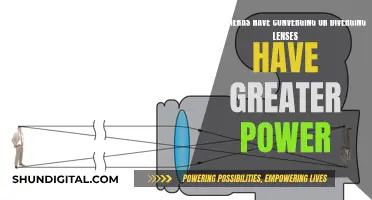
Camera lenses can drastically alter the way a face appears in a photograph. This phenomenon is called lens distortion, and it occurs because lenses bend light rays and capture a two-dimensional picture within a limited field of view. The distortion depends on the lens' focal length, with shorter focal lengths resulting in more distortion and longer focal lengths leading to flatter and wider images. Different focal lengths can make a face appear thinner or rounder, with shorter focal lengths distorting images inward. The position of the camera in relation to the subject also plays a crucial role in the level of distortion. By adjusting the focal length and camera distance, photographers can manipulate the appearance of their subjects, making them seem more or less attractive.
| Characteristics | Values |
|---|---|
| Reason for distortion | Camera lenses tend to bend light and capture a two-dimensional picture in a limited field. |
| Factors affecting distortion | Focal length, distance from the camera, lighting, and angle. |
| Effect of focal length | Shorter focal length increases distortion and makes the face look thinner, while a longer focal length makes the face look flatter and wider. |
| Effect of distance | Closer distance to the camera makes the face look larger, while a farther distance makes the face look smaller. |
What You'll Learn

Lens distortion
The two most common types of lens distortion are barrel distortion and pincushion distortion. Barrel distortion is where straight lines bend outward from the centre of the image. Pincushion distortion is where straight lines bend or "pinch" inward from the centre of the image.
Barrel distortion is common with wide-angle prime lenses, such as a 20mm lens, or zoom lenses like the Nikon 24-70mm shot at its wide end. It is noticeable in architectural images, where the lines of buildings bow outward, and in portraits, where it can make subjects look pudgy or large-headed.
Pincushion distortion usually occurs at the telephoto end of a zoom lens, such as a 70-200mm lens. It can be desirable for portraits as it can make people look thinner.
Portrait photographers usually use long focal lengths (at least 85mm) as this is thought to produce a more 'natural' and flattering portrait.
Analog Camera Lenses: Interchangeable or Not?
You may want to see also

Focal length
Camera lenses can alter the way a face appears in a photograph, and this is largely due to focal length. Focal length is a fundamental parameter of a lens that describes how strongly it focuses or diverges light. Lenses with longer focal lengths bend light gradually, while those with shorter focal lengths bend light at sharper angles.
The shorter the focal length, the more field of view can be captured. This is why a shorter focal length can make the subject appear distorted, stretched, or thinner. For example, a 15mm fish-eye lens will result in obvious distortion, making the face appear extremely deformed.
Conversely, longer focal lengths can make the face appear flatter and wider. For instance, a 350mm lens will also distort the face, but in a different way, making it look wider.
Photographers can use this knowledge to their advantage to make their subjects appear more flattering in photographs. For example, by using a shorter focal length, the photographer can make the subject appear thinner. However, it is important to note that the distortion caused by shorter focal lengths can be quite obvious, and may not always be desirable.
In general, a focal length of around 135mm is considered to produce the most accurate and flattering results, but this can vary depending on the subject's anatomy. Some people may find that they appear more photogenic with certain focal lengths and at specific angles.
Additionally, the placement of the subject within the frame can also affect how they appear. For instance, placing the subject in the center of the frame may be more flattering than having them at the sides, where distortion is more obvious.
In summary, by understanding and manipulating focal length, photographers can enhance or alter the appearance of their subjects' faces, making them appear more or less attractive as desired.
The Future of Photography: Cameras in Contact Lenses
You may want to see also

Face shape
The shape of a person's face in a photograph is altered by the focal length of the lens used. The shorter the focal length, the more field of view can be captured, and the more distorted the image becomes. This distortion can make a face appear thinner or wider, depending on the lens used.
A longer focal length, such as a 135mm lens, will produce more accurate results, but this also depends on the subject's anatomy. For example, a shorter focal length can be more flattering for female clients as it forces the photographer to get closer to the subject, causing body parts to overlap in more complementary ways.
The same effect can be achieved by moving the camera closer to or further from the subject. When the camera is closer, the distance between the subject's features is more substantial, and the nose will appear larger. As the camera moves further away, the relative distance between features decreases, and the nose will appear smaller in the photograph.
The lens used can also affect the perception of weight. Shooting from far away with a telephoto lens can flatten the subject and make them look heavier. A shorter focal length, on the other hand, can be more flattering, especially for those self-conscious about their weight, as it forces the photographer to get closer, causing body parts to overlap in more complementary ways.
The position of the camera can also affect the appearance of the face. Placing the subject in the centre of the frame can make them look better, while moving them to the sides can make them look less attractive.
Understanding Camera Lens Interchangeability: What You Need to Know
You may want to see also

Anatomy
The anatomy of the face plays a crucial role in how it is portrayed through a camera lens. The positioning and structure of various facial features, such as the eyes, nose, and chin, can be accentuated or minimised depending on the lens used and the distance from the camera.
Different lenses can alter the perceived shape of the face. For example, a shorter focal length can make the nose appear larger as it is closer to the lens, while a longer focal length can make the face look flatter and wider. The distance between the camera and the subject also plays a significant role in the distortion of facial features. When the camera is closer to the subject, the distance between their features appears more substantial, which can lead to a distorted image. As the camera moves further away, the relative distances between these features seem more proportional.
Additionally, the angle from which the photo is taken can impact the appearance of the face. Shooting from a slightly higher angle can make the head look larger in proportion to the body, while angling the hips back and bringing the chest and shoulders closer to the camera can create a more balanced look.
The choice of lens and camera distance can either fortify or uglify the face, depending on the individual's unique facial anatomy. Some people are considered "photogenic" because their facial features suit most camera lenses and angles, resulting in aesthetically pleasing photographs.
Old Lenses, New Cameras: Is There Compatibility?
You may want to see also

Lighting
When it comes to lighting for portrait photography, there are a few key considerations. Firstly, the direction of the light source is important. Frontal lighting, where the light source is directly in front of the subject, can result in flat-looking images with minimal depth. On the other hand, side lighting creates shadows and highlights that accentuate the subject's features, adding depth and dimension to the image.
The intensity of the light source is another factor to consider. A bright, harsh light source can create strong shadows and highlight imperfections, while a softer, diffused light can give a more flattering result. Playing with the distance and proximity of the light source to the subject can help control the intensity of the light.
Additionally, the colour temperature of the light source is important. Natural light, such as sunlight, has a different colour temperature throughout the day, ranging from warm tones during sunrise and sunset to cooler tones during midday. Artificial light sources, such as studio lights or flash, can be adjusted to match the desired colour temperature. Using the appropriate white balance settings on your camera can also help ensure that skin tones are accurately represented.
The use of reflectors and diffusers can also help modify the lighting. Reflectors bounce light back onto the subject, filling in shadows and adding brightness to the image. Diffusers, on the other hand, soften the light, reducing harsh shadows and creating a more even lighting pattern.
Backlighting, where the light source is behind the subject, can create a glowing effect around the person's head and hair, adding an ethereal quality to the image. However, it can also make the subject appear darker, so fill flash or reflectors may be needed to ensure the person's face is properly illuminated.
Understanding how to manipulate lighting is a powerful tool for any photographer. It can be used to enhance the subject's features, create a specific mood or atmosphere, and even convey a particular message or emotion.
Full-Frame Lenses: Sharper on Crop Sensor Cameras?
You may want to see also
Frequently asked questions
Camera lenses are not like our eyes. They bend light rays and capture a two-dimensional picture within a limited field of view, resulting in lens distortion. The distortion depends on the lens' focal length, with shorter focal lengths causing more distortion.
A shorter focal length will make your face appear thinner and more distorted, while a longer focal length will make your face look flatter and wider.
To take more flattering pictures, you can adjust the focal length of your camera lens or the distance between yourself and the camera. Shooting with a longer focal length or from further away will reduce distortion and make your face appear more proportional.







